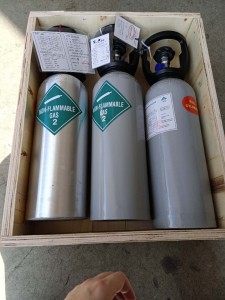In environmental testing, standard gas is the key to ensure measurement accuracy and reliability. The following are some of the main requirements for standard gas:
Gas purity
High purity: The purity of the standard gas should be higher than 99.9%, or even close to 100%, to avoid interference of impurities in the measurement results. The specific purity requirements may vary according to the requirements of the detection method and the target analyte. 1.2 Low background interference: The standard gas should exclude substances that interfere with the analytical method as much as possible. This means that the impurity content needs to be controlled during the manufacturing and filling process of the standard gas to ensure its separation and identification from the substance to be measured.
Low background interference: Substances that interfere with the analytical method should be excluded as much as possible from the standard gas. This means that the content of impurities needs to be well controlled during the manufacturing and filling process of the standard gas to ensure its separation and identification from the substance to be tested.
Concentration stability
Concentration maintenance: The standard gas should maintain a stable concentration during its validity period. Changes in concentration can be verified by regular testing. Manufacturers usually provide relevant data on concentration stability and validity period.
Validity period: The validity period of the standard gas should be clearly marked and is usually valid for a certain period of time after the production date. After the validity period, the concentration of the gas may change, requiring recalibration or replacement of the gas.
Certification and calibration
Certification: Standard gases should be provided by certified gas suppliers that meet international or national quality standards.
Calibration certificate: Each bottle of standard gas should be accompanied by a calibration certificate, including the gas concentration, purity, calibration date, calibration method and its uncertainty.
Cylinders and packaging
Gas cylinder quality: Standard gases should be stored in high-quality gas cylinders that meet safety standards. Commonly used materials are steel cylinders, aluminum cylinders or composite cylinders. Gas cylinders should undergo strict quality inspections and maintenance to prevent leakage and safety hazards.
Outer packaging: Gas cylinders should be properly packaged during transportation and storage to avoid damage. The packaging material should have shockproof, anti-collision and anti-leakage functions.
Storage and Transportation
Storage conditions: Gas cylinders should be stored in dry and ventilated places, avoiding extreme environments such as high temperature, low temperature, direct sunlight and humidity. The storage environment of gas cylinders should comply with relevant safety regulations, and temperature changes should be controlled within the specified range as much as possible.
Transportation safety: Standard gases should be transported in containers and equipment that meet transportation safety standards, such as shock-proof brackets, protective covers, etc. Transport personnel should receive training and understand the safe operation and emergency handling procedures of gas cylinders.
Use and maintenance
Operational specifications: When using standard gas, you should follow the operating procedures, such as correctly installing the gas cylinder, adjusting the flow, controlling the pressure, etc. Avoid abnormal conditions such as gas leakage, overpressure or low pressure.
Maintenance records: Establish and maintain detailed records, including gas procurement, usage, remaining amount, inspection records, calibration and replacement history, etc. These records help track the use status of the gas and ensure the accuracy of the measurement.
Compliance with standards and regulations
International and national standards: Standard gases should comply with relevant international (such as ISO) or national (such as GB) standards. These standards specify requirements such as gas purity, concentration, calibration methods, etc.
Safety regulations: When using standard gases, relevant safety regulations should be observed, such as safety requirements for gas storage, handling and transportation. Corresponding safety operating procedures and emergency response plans should be formulated in the laboratory.
Post time: Nov-14-2024













